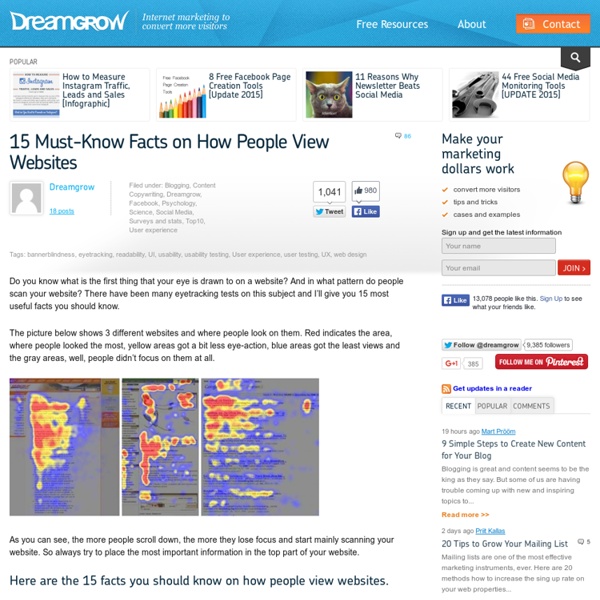100 Websites You Should Know and Use
In the spring of 2007, Julius Wiedemann, editor in charge at Taschen GmbH, gave a legendary TED University talk: an ultra-fast-moving ride through the “100 websites you should know and use.” Six years later, it remains one of the most viewed TED blog posts ever. Time for an update? We think so.
50 Viral Images The Web Shared In 2010
As a perpetual observer/analyzer of what people share and why, it’s fascinating to me to study content that spreads. As such, I document/bookmark much of the web’s hottest content for my own insight/analysis, but I also share with readers here too. Images have always been one of the most popular types of content on the web, (even through the popularization of video) and I’m always surprised more marketing and PR folk don’t actively use them as part of their content mixes.
5 Tips On How To Make Your Blog Visitors Stay Longer
The length of time that you can keep your visitors on your website can be a crucial factor in determining how successful your blog will be. Simply getting traffic in the form of thousands of unique visitors daily is meaningless if the time they spend on your site is less than a few seconds or your bounce rate is more than 95%. There are certain things you can do in the way you present your pages and posts which will maximize the chances of your visitors sticking around for a longer period on your site. The longer people stay the greater your opportunity to monetize their visit or convince them to take your desired call to action.
30 Days to Learn HTML & CSS - Free Tuts+ Premium Course
Reactive programming is a way of coding with asynchronous data streams that makes a lot of problems easier to solve. RxJS is a popular library for reactive...Once in a while, it's important for us as developers to go back to what made us excited about computers in the first place. For Derek Jensen, that is gaming....React is a flexible framework that makes it easy to build single-page web applications.
The Anatomy of a Perfect Landing Page
Placement and Content 7. Keep It Above the Fold The space a visitor sees without having to scroll is where the most important parts of the webpage should be. Place the call-to-action button above the fold and in a location where the viewer's eye will scan to. Never have the button or form in a place where it has to be searched for.
10 reasons your Wi-Fi speed stinks (and what you can do about it)
May 09, 2012, 4:44 PM — The first 801.11ac chipsets are coming soon, but 802.11n is likely to stick around for many years to come -- both in the business world and our homes. Unfortunately, the 300Mbps (megabits per second) that the n-standard promises rarely delivers anything even close and proves to be a massive bottleneck in the days of 50/100Mbps (or more?) broadband connections, 1080p video streaming, massive backups and so forth. On the business side of things, even menial tasks such as remote desktop or real-time collaboration suffer from a poor Wi-Fi-connection.
Understanding the Importance of Landing and Sales Pages
Relevance is the most important factor when you are advertising on the Internet. The more relevant the keywords are to your ad text and your product or service, the more likely the ads will be to get clicked on by users who are actively searching for you and your business. The landing page is the page specifically designed as the entrance point for the users that click on your ad or contextual link and its job is to convince them to perform the relevant call-to-action which you want them to. But the biggest downfall of any Adwords or advertising campaign in general is when users land on poor quality or irrelevant landing pages. Spending money on Adwords and other advertising campaigns without having a proper landing page is like throwing money down the drain. Landing pages are one of the key components as part of your overall marketing strategy which you should strive to get right.
Best Photoshop Tutorials
Photoshop is what makes the virtual world seem alive. Its nothing less than a blessing for designers. The Internet is full of Photoshop Tutorials and you will find a tutorial on each and every tool.
50 Awesome Posts on Email Marketing
Learn the ins and outs of email marketing, including building your email list, crafting the best email content, email newsletter design, and more in this list of 50 awesome posts on email marketing from 2011. Yup, there’s 50 of them, and they’re all awesome. Bloggers, small or large businesses, and Internet marketers can all learn something from this entire collection…
How to Create a Retro Boxing Poster in Photoshop
As it's Graphic Design Week here on Psdtuts+, let's take a look at some basic Graphic Design principles and cast an eye over the Boxing Poster aesthetic from yesteryear. Creating a retrograde look is nothing new, but there are some things to keep an eye out for when mimicking Graphic Design from any decades past. We'll be drawing inspiration from Poster Design from the 1960s, particularly Boxing Posters from that era. Let's get started!
Websites Are The New Shop Windows
By Ben Weiner, CEO, Conjungo I used to be asked quite often whether people or a company would need a website regardless of whether they had the capability or need to sell their products over the Internet. My answer was and still is a resounding ‘yes’.



